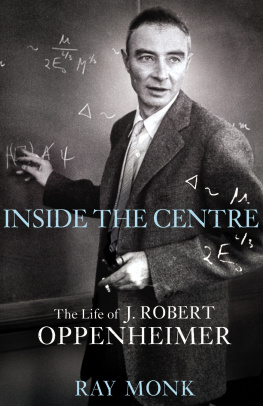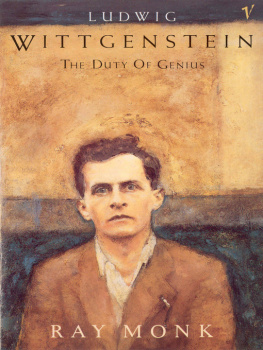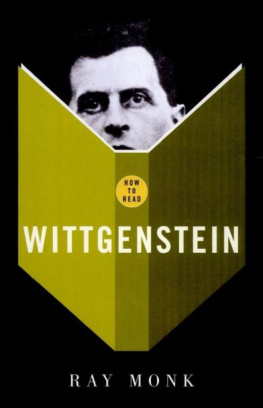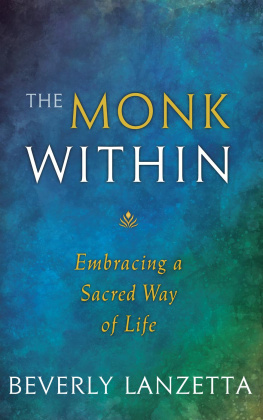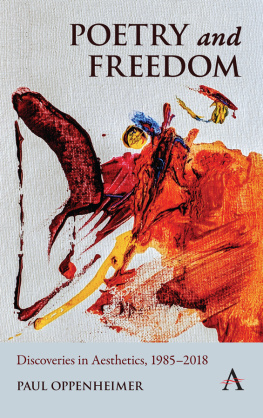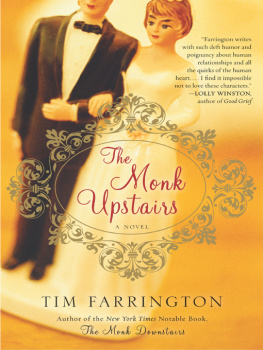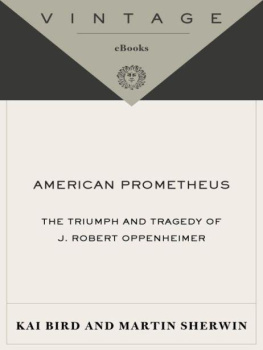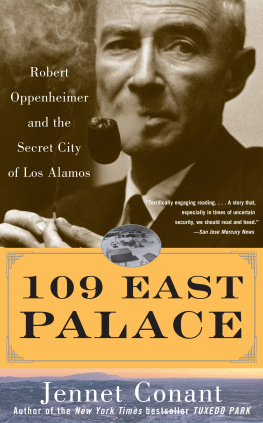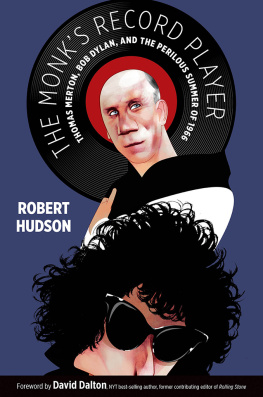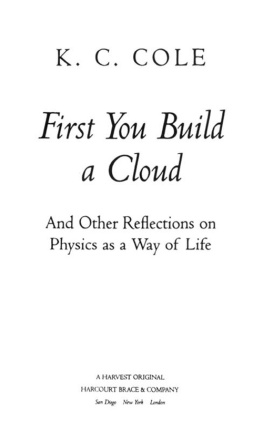Ray Monk - Inside The Centre: The Life of J. Robert Oppenheimer
Here you can read online Ray Monk - Inside The Centre: The Life of J. Robert Oppenheimer full text of the book (entire story) in english for free. Download pdf and epub, get meaning, cover and reviews about this ebook. year: 2012, publisher: Jonathan Cape, genre: Religion. Description of the work, (preface) as well as reviews are available. Best literature library LitArk.com created for fans of good reading and offers a wide selection of genres:
Romance novel
Science fiction
Adventure
Detective
Science
History
Home and family
Prose
Art
Politics
Computer
Non-fiction
Religion
Business
Children
Humor
Choose a favorite category and find really read worthwhile books. Enjoy immersion in the world of imagination, feel the emotions of the characters or learn something new for yourself, make an fascinating discovery.
Inside The Centre: The Life of J. Robert Oppenheimer: summary, description and annotation
We offer to read an annotation, description, summary or preface (depends on what the author of the book "Inside The Centre: The Life of J. Robert Oppenheimer" wrote himself). If you haven't found the necessary information about the book — write in the comments, we will try to find it.
Inside The Centre: The Life of J. Robert Oppenheimer — read online for free the complete book (whole text) full work
Below is the text of the book, divided by pages. System saving the place of the last page read, allows you to conveniently read the book "Inside The Centre: The Life of J. Robert Oppenheimer" online for free, without having to search again every time where you left off. Put a bookmark, and you can go to the page where you finished reading at any time.
Font size:
Interval:
Bookmark:
Contents
J. Robert Oppenheimer is among the most contentious and important figures of the twentieth century. As head of the Los Alamos Laboratory, he oversaw the successful effort to beat the Nazis to develop the first atomic bomb a breakthrough which was to have eternal ramifications for mankind, and made Oppenheimer the father of the Bomb.
Oppenheimer was a man of diverse interests and phenomenal intellectual attributes. His talent and drive allowed him, as a young scientist, to enter a community peopled by the great names of twentieth-century physics men such as Bohr, Born, Dirac and Einstein and to play a role in the laboratories and classrooms where the world was being changed forever.
But Oppenheimers was not a simple story of assimilation, scientific success and world fame. A complicated and fragile personality, the implications of the discoveries at Los Alamos were to weigh heavily upon him. Having formed suspicious connections in the 1930s, in the wake of the Allied victory in World War Two, Oppenheimers attempts to resist the escalation of the Cold War arms race would lead many to question his loyalties and set him on a collision course with Senator Joseph McCarthy and his witch hunters.
As with Ray Monks peerless biographies of Wittgenstein and Bertrand Russell, Inside the Centre is a work of towering scholarship. A story of discovery, secrecy, impossible choices and unimaginable destruction, it goes deeper than any previous work in revealing the motivations and complexities of this most brilliant and divisive of men.
Ray Monk is the author of Ludwig Wittgenstein: The Duty of Genius for which he won the Mail on Sunday/John Llewellyn Rhys Prize and the Duff Cooper Award, and Bertrand Russell: The Spirit of Solitude. He is Professor of Philosophy at the University of Southampton.
Ludwig Wittgenstein: The Duty of Genius
Bertrand Russell: The Spirit of Solitude
Bertrand Russell: The Ghost of Madness
Oppenheimer with his mother ( Historical/CORBIS);
Oppenheimer in the arms of his father ( Historical/CORBIS);
Oppenheimer building with blocks ( Historical/CORBIS);
155 Riverside Drive ( Milstein Division of United States History, Local History and Genealogy, The New York Public Library, Astor, Lenox and Tilden Foundations);
Oppenheimer at Harvard ( Harvard University Archives);
William Boyd ( The National Library of Medicine);
Frederick Bernheim (image provided by the Duke Medical Center Archives);
Paul Horgan ( J. R. Eyerman/Time & Life Pictures/Getty Images);
The Upper Pecos Valley (courtesy of the Palace of the Governors Photo Archives, New Mexico History Museum, Santa Fe/053755);
Inside the Cavendish Laboratory, Cambridge ( Omikron/Science Photo Library);
Paul Dirac ( Bettmann/CORBIS);
Patrick Blackett ( Science Photo Library);
Niels Bohr ( Lawrence Berkeley Laboratory/Science Photo Library);
Max Born ( Bettmann/CORBIS);
Charlotte Riefenstahl ( Gttingen Museum of Chemistry);
Werner Heisenberg ( Bettmann/CORBIS);
Paul Ehrenfest;
Oppenheimer on Lake Zurich with I. I. Rabi, H. M. Mott-Smith and Wolfgang Pauli ( AIP Emilio Segr Visual Archives);
Oppenheimer at Berkeley (courtesy of the Department of Physics, Physics and Astronomy Library);
Oppenheimer with Robert Serber ( New York Times/Redux/eyevine);
Ernest Lawrence ( AIP Emilio Segr Visual Archives);
Kitty ( Historical/CORBIS);
Perro Caliente ( Peter Goodchild);
Haakon Chevalier (courtesy of The Bancroft Library, University of California, Berkeley);
Frank Oppenheimer;
Jean Tatlock ( Dr Hugh Tatlock);
Steve Nelson ( United Press International Photos);
Joe Weinberg, Rossi Lomanitz, David Bohm and Max Friedman;
Radiation Laboratory sitting on the 60-inch ( Science Source/Science Photo Library)
Julian Schwinger ( Estate of Francis Bello/Science Photo Library);
Richard Feynman ( Tom Harvey);
The Los Alamos Ranch School ( Digital Photo Archive, Department of Energy (DOE), courtesy AIP Emilio Segr Visual Archives);
General Groves ( Los Alamos National Laboratory/Science Photo Library);
Enrico Fermi ( Argonne National Laboratory/Science Photo Library);
The graphite pile at Stagg Field ( Historical/CORBIS);
Hans Bethe ( Science Source/Science Photo Library);
Klaus Fuchs ( Keystone/Time & Life Pictures/Getty Images);
Edward Teller ( University of California Radiation Laboratory/Science Photo Library);
Seth Neddermeyers early attempts at implosion (courtesy of the Los Alamos National Laboratory Archives);
The Nagasaki and Hiroshima bombs (Claus Lunau/Science Photo Library);
The Little Boy design, as reverse engineered by John Coster-Mullen;
Workers at Oak Ridge ( Oak Ridge National Laboratory and Digital Photo Archive, Department of Energy (DOE), courtesy AIP Emilio Segr Visual Archives);
Preparing the Trinity Test (courtesy of the Los Alamos National Laboratory Archives);
Preparing the Trinity Test, landscape (courtesy of the Los Alamos National Laboratory Archives);
The Trinity explosion ( Historical/CORBIS);
Oppenheimer and Groves at the Trinity Test site (Emilio Segr Visual Archives/American Institute of Physics/Science Photo Library);
The effects of the atomic bombs in Japan (courtesy of the Los Alamos National Laboratory Archives);
Oppenheimer and Kitty in Japan, 1960 ( Historical/CORBIS);
The cover of the first issue of Physics Today (courtesy of Berkeley Laboratory);
Albert Einstein and Leo Szilard ( Time & Life Pictures/Getty Images)
The Ulam-Teller design ( Carey Sublette and the NuclearWeaponArchive.org);
The Mike Test;
Oppenheimer lectures Ed Murrow ( Bettmann/CORBIS);
Oppenheimer with Paul Dirac and Abraham Pais at the Institute for Advanced Study ( Alfred Eisenstaedt/Getty Images);
Oppenheimer, Toni and Peter at Olden Manor, Princeton ( Alfred Eisenstaedt/Time & Life Pictures/Getty Images);
Lewis Strauss ( Bettmann/CORBIS);
Edward Teller congratulates Oppenheimer on his Fermi Prize ( Ralph Morse/Time & Life Pictures/Getty Images);
Oppenheimer speaking at last visit to Los Alamos ( Oppenheimer Archives/CORBIS);
Oppenheimer photographed for Life magazine ( Time & Life Pictures/Getty Images)

THE ORIGINS OF this book lie in a review I wrote about fifteen years ago of a reissued edition of Robert Oppenheimer: Letters and Recollections, edited by Alice Kimball Smith and Charles Weiner. Until then, I knew about Oppenheimer only what everybody knows: that he was an important physicist, that he led the project to design and build the worlds first atomic bomb, and that he had his security clearance taken away from him during the McCarthy era because of suspicions that he was a communist, or even possibly a Soviet agent.
What I did not know until I read this collection of his letters was what a fascinatingly diverse man he was. I did not know that he wrote poetry and short stories, that he had a deep love and wide knowledge of French literature, that he found the Hindu scriptures so inspiring that he learned Sanskrit in order to read them in their original language. Nor did I know how complicated and fragile his personality was, nor how intense his personal relations were with his father, his mother, his girlfriends, his friends and his students.
Next pageFont size:
Interval:
Bookmark:
Similar books «Inside The Centre: The Life of J. Robert Oppenheimer»
Look at similar books to Inside The Centre: The Life of J. Robert Oppenheimer. We have selected literature similar in name and meaning in the hope of providing readers with more options to find new, interesting, not yet read works.
Discussion, reviews of the book Inside The Centre: The Life of J. Robert Oppenheimer and just readers' own opinions. Leave your comments, write what you think about the work, its meaning or the main characters. Specify what exactly you liked and what you didn't like, and why you think so.

